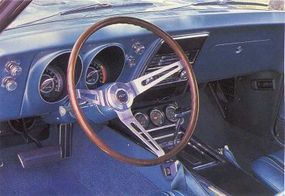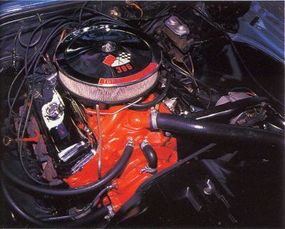GM spotted Ford more than two years and 1.3 million Mustangs before answering the pony-car challenge. When it did, the 1967 Chevrolet Camaro SS 396 had instant muscle car credibility.
Advertisement
From the start, Camaro featured a Super Sport edition as an authoritative counterpunch to the Mustang GT. It added $211 to the $2,572 Camaro Sport Coupe or the $2,809 convertible. Included were firmer springs and shocks, wide-oval tires, a special hood with die-cast simulated louvers, and a bumblebee stripe around the car's nose. Many buyers combined it with the $105 Rally Sport package, which included hidden headlamps.

A new 295-bhp four-barrel 350-cid V-8 was the standard SS engine. With a four-speed and 3.31:1 gears, Motor Trend's SS 350 ran 0-60 in 8 seconds and the quarter in 15.4 at 90 mph. That was directly comparable to a 335-bhp 390-cid Mustang GT.
Then, a few months into the model year, Chevy unleashed the SS 396. It initially came in 325-bhp tune and tacked $263 onto the SS group. Still later in the year, the 375-bhp L78 variant was offered for $500. Since the L78 violated GM's rule against any car except the Corvette exceeding 10-pounds-per horsepower, it technically was listed as a dealer-installed option. (A few high-performance dealers also would install a 400-hp-plus 427-cid V-8.) SS 396 Camaros came standard with a four-speed manual; the three-speed automatic was a $226 option.

With inadequate single-leaf rear springs and a near-vertical mounting of the rear shock absorbers, all V-8 Camaros were handicapped by severe rear-wheel hop in hard acceleration. With more weight over the nose and additional torque, the 396s suffered even more. But no rival was quicker.
First-year Camaro sales trailed those racked up by Mustang by a wide margin, but of the 220,917 sold, more than 34,000 were Super Sports. Chevy's pony car was off and running.
Return to Classic Muscle Cars Library.
For more cool information on muscle cars, see:
- Chevy muscle cars beat at the heart of big-cube high performance. See profiles, photos, and specifications of more Chevy muscle cars.
- Muscle cars came in many shapes and sizes. Here are features on more than 100 muscle cars, including photos and specifications for each model.
- Muscle cars created their own culture. To learn about it, read How Muscle Cars Work.
Advertisement
